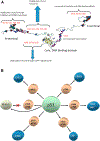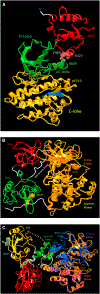Allosteric conformational barcodes direct signaling in the cell
- PMID: 24010710
- PMCID: PMC6361540
- DOI: 10.1016/j.str.2013.06.002
Allosteric conformational barcodes direct signaling in the cell
Abstract
The cellular network is highly interconnected. Pathways merge and diverge. They proceed through shared proteins and may change directions. How are cellular pathways controlled and their directions decided, coded, and read? These questions become particularly acute when we consider that a small number of pathways, such as signaling pathways that regulate cell fates, cell proliferation, and cell death in development, are extensively exploited. This review focuses on these signaling questions from the structural standpoint and discusses the literature in this light. All co-occurring allosteric events (including posttranslational modifications, pathogen binding, and gain-of-function mutations) collectively tag the protein functional site with a unique barcode. The barcode shape is read by an interacting molecule, which transmits the signal. A conformational barcode provides an intracellular address label, which selectively favors binding to one partner and quenches binding to others, and, in this way, determines the pathway direction, and, eventually, the cell's response and fate.
Copyright © 2013 Elsevier Ltd. All rights reserved.
Figures





Similar articles
-
PTMScan direct: identification and quantification of peptides from critical signaling proteins by immunoaffinity enrichment coupled with LC-MS/MS.Mol Cell Proteomics. 2012 May;11(5):187-201. doi: 10.1074/mcp.M111.015883. Epub 2012 Feb 9. Mol Cell Proteomics. 2012. PMID: 22322096 Free PMC article.
-
Attractor Structures of Signaling Networks: Consequences of Different Conformational Barcode Dynamics and Their Relations to Network-Based Drug Design.Mol Inform. 2014 Jun;33(6-7):463-8. doi: 10.1002/minf.201400029. Epub 2014 May 20. Mol Inform. 2014. PMID: 27485984
-
Networks for the allosteric control of protein kinases.Curr Opin Struct Biol. 2006 Dec;16(6):686-92. doi: 10.1016/j.sbi.2006.10.011. Epub 2006 Nov 7. Curr Opin Struct Biol. 2006. PMID: 17085044 Review.
-
Dynamic View of Allosteric Regulation in the Hsp70 Chaperones by J-Domain Cochaperone and Post-Translational Modifications: Computational Analysis of Hsp70 Mechanisms by Exploring Conformational Landscapes and Residue Interaction Networks.J Chem Inf Model. 2020 Mar 23;60(3):1614-1631. doi: 10.1021/acs.jcim.9b01045. Epub 2020 Jan 21. J Chem Inf Model. 2020. PMID: 31935082
-
Scaffold proteins: hubs for controlling the flow of cellular information.Science. 2011 May 6;332(6030):680-6. doi: 10.1126/science.1198701. Science. 2011. PMID: 21551057 Free PMC article. Review.
Cited by
-
Oligomerization and nanocluster organization render specificity.Biol Rev Camb Philos Soc. 2015 May;90(2):587-98. doi: 10.1111/brv.12124. Epub 2014 Jun 11. Biol Rev Camb Philos Soc. 2015. PMID: 24917483 Free PMC article. Review.
-
Review: Precision medicine and driver mutations: Computational methods, functional assays and conformational principles for interpreting cancer drivers.PLoS Comput Biol. 2019 Mar 28;15(3):e1006658. doi: 10.1371/journal.pcbi.1006658. eCollection 2019 Mar. PLoS Comput Biol. 2019. PMID: 30921324 Free PMC article. Review.
-
Dancing through Life: Molecular Dynamics Simulations and Network-Centric Modeling of Allosteric Mechanisms in Hsp70 and Hsp110 Chaperone Proteins.PLoS One. 2015 Nov 30;10(11):e0143752. doi: 10.1371/journal.pone.0143752. eCollection 2015. PLoS One. 2015. PMID: 26619280 Free PMC article.
-
ASD v3.0: unraveling allosteric regulation with structural mechanisms and biological networks.Nucleic Acids Res. 2016 Jan 4;44(D1):D527-35. doi: 10.1093/nar/gkv902. Epub 2015 Sep 13. Nucleic Acids Res. 2016. PMID: 26365237 Free PMC article.
-
Multiple conformational selection and induced fit events take place in allosteric propagation.Biophys Chem. 2014 Feb;186:22-30. doi: 10.1016/j.bpc.2013.10.002. Epub 2013 Oct 31. Biophys Chem. 2014. PMID: 24239303 Free PMC article. Review.
References
-
- Antal MA, Bode C, and Csermely P (2009). Perturbation waves in proteins and protein networks: applications of percolation and game theories in signaling and drug design. Curr. Protein Pept. Sci. 10, 161–172. - PubMed
-
- Arima K, Kinoshita A, Mishima H, Kanazawa N, Kaneko T, Mizushima T, Ichinose K, Nakamura H, Tsujino A, Kawakami A,et al.(2011). Protea- some assembly defect due to a proteasome subunit beta type 8 (PSMB8) mutation causes the autoinflammatory disorder, Nakajo-Nishimura syndrome. Proc. Natl. Acad. Sci. USA 108, 14914–14919. - PMC - PubMed
-
- Benayoun BA, and Veitia RA (2009). A post-translational modification code for transcription factors: sorting through a sea of signals. Trends Cell Biol. 19, 189–197. - PubMed
Publication types
MeSH terms
Substances
Grants and funding
LinkOut - more resources
Full Text Sources
Other Literature Sources

